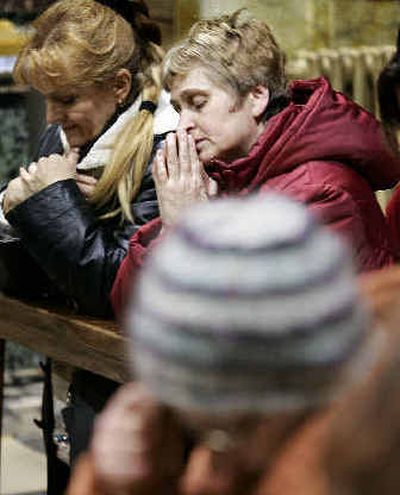Pope’s surgery a success

VATICAN CITY – Pope John Paul II underwent a successful operation Thursday night to insert a tube in his throat to relieve his breathing problems, hours after he was rushed back to the hospital for the second time in a month with flulike symptoms of fever and congestion, the Vatican said.
The pontiff was conscious in his hospital room after the tracheotomy, breathing with the help of a respirator, the Italian news agency ANSA reported.
A top aide to Italian Prime Minister Silvio Berlusconi who visited the pope Thursday said John Paul was “serene” after waking up from the anesthesia. The pope raised his hand and attempted to speak with doctors but was told not to try, Cabinet Undersecretary Gianni Letta told reporters at Gemelli Polyclinic Hospital in Rome.
Vatican spokesman Joaquin Navarro-Valls said the tracheotomy lasted 30 minutes and that the outcome was “positive.” The pope had approved the procedure, which the Vatican characterized as elective – underscoring that it was not done as an emergency measure.
The frail, 84-year-old pontiff, who was taken to the hospital shortly before 11 a.m. in an ambulance, was to spend the night in his hospital room, Navarro-Valls said.
But the tracheotomy may require a longer hospital stay and have serious consequences for the pope’s abilities to carry out his duties since he will not be able to speak, at least initially, while the breathing tube is in his throat.
Medical experts said the respirator was a serious development. “The fact that he is on a respirator is not good. The fact that he was readmitted so quickly is not good. All this suggests there’s a serious problem,” said Dr. Michael Kaplitt, a Parkinson’s disease expert at New York Presbyterian Hospital/Weill Cornell Medical Center.
Before the tracheotomy, outside medical experts had said John Paul may have pneumonia. However, Navarro-Valls’ statement made no reference to pneumonia, saying the pope suffered a narrowing of his larynx.
In recent days, the pope appeared to be recuperating from an illness that kept him in the hospital for 10 days earlier this month. On Wednesday, he gave a 30-minute audience by video hookup, reading a statement in six languages before waving and giving his blessing at the end.
With each successive appearance, he seemed a little stronger, a little more alert, and his voice rang out with greater clarity.
That made Thursday’s reversal all the more shocking for the faithful from Nigeria to the Philippines to St. Peter’s Square, and raised more doubts about his ability to carry on.
“We have prayed for the pope to live as long as possible so we can still share our joy with him,” said Zofia Gebala, a 73-year-old retiree, as she left a church in Wadowice, the pope’s birthplace in southern Poland. “We are praying for him every day, for his well-being. But it’s all in God’s hands now.”
Papal officials played down the seriousness of the hospitalization, saying a patient of the pope’s age is always at risk from the flu. Vatican aides said the pope had a fever and congestion in addition to the breathing problems.
ANSA reported the pope was conscious when he arrived at Gemelli and that he was sitting upright in a stretcher. According to the report, people who saw him enter the hospital said his face looked “quite relaxed.”
Before the operation, the pope was well enough to joke with his medical team, Letta said. When doctors told the pope that the operation would be a small one, the pontiff retorted: “Small, it depends for whom,” he said, citing doctors’ accounts.
Earlier Thursday, Vatican officials had said the pope suffered from a “syndrome of influenza.”
Chile’s ambassador to the Holy See, Maximo Pacheco, told the Associated Press that the pope suffered a “bad relapse,” citing a conversation he had with the Vatican’s secretary of state, Cardinal Angelo Sodano.
But outside experts said people don’t get a relapse of influenza itself. Instead, flu can lead to a bacterial infection such as pneumonia or bronchitis, which is an inflammation of the tubes that carry air into the lungs, or to congestive heart failure, a treatable condition in which the heart is unable to pump enough blood to meet the body’s needs.
Thursday’s hospitalization was the pope’s eighth since his election in 1978.